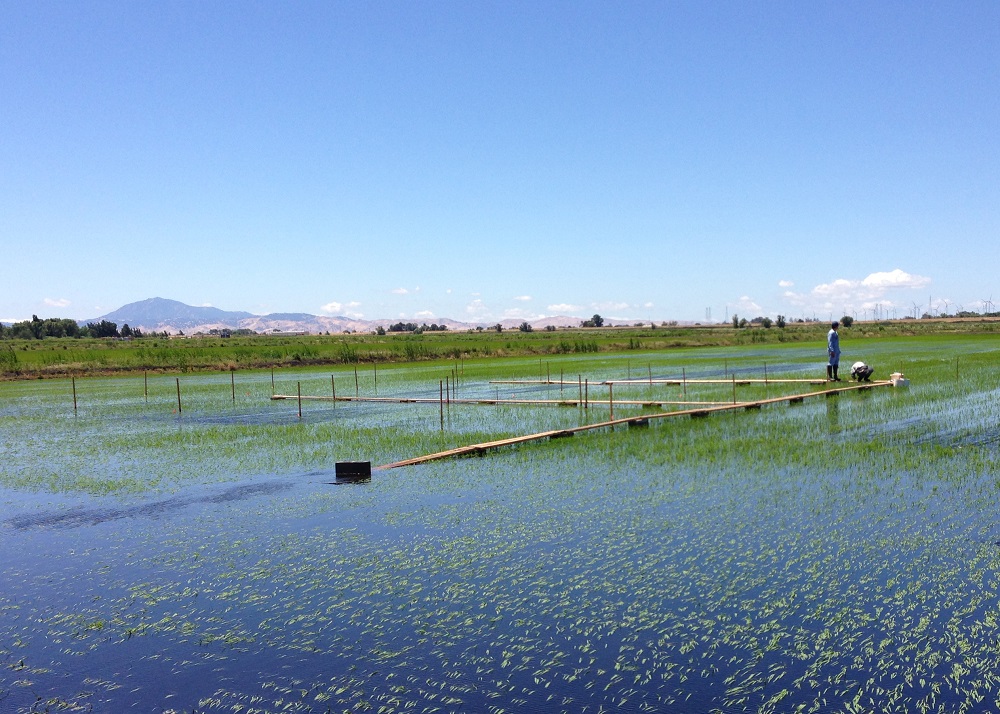07/21/2017
Scaling Microbial Genomics Discoveries for Ecosystem Modeling
Nutrient availability in model wetlands helps regulate microbial metabolism and soil carbon cycling rates.

Study co-author Rhonzhong Ye and graduate student Jennifer Morris collecting greenhouse gas fluxes from the rice fields studied on Twitchell Island, CA.
Image courtesy DOE Joint Genome Institute
The Science
Researchers linked microbial metabolism and nutrient availability to soil carbon cycling rates by studying microbial communities in San Joaquin Delta rice fields.
The Impact
Establishing the inter-relationships among microbial metabolism, nutrient availability and soil carbon cycling rates is critical to applying genomic information to understand the global carbon cycle. In showing how microbial metabolism is regulated by coupled nutrient cycling and soil carbon availability, researchers demonstrate how genomics studies of microbial communities can be scaled up to the ecosystems level. This will contribute to a deeper understanding of ecological processes and will aid the development of better global carbon cycling models.
Summary
To better understand the relationship between carbon cycling, nutrient availability, and microbial communities in soil, it is necessary to conduct studies across a nutrient gradient. Rice fields are model wetland systems that allow researchers to focus on chosen biogeochemical variables, while factors such as water and vegetation are controlled. Adjacent to the Twitchell Island restored wetlands are rice fields with soil carbon contents that can vary between 2.5 percent and 25 percent, covering much of the global range of carbon found in soils.
Wetlands are of interest to the U.S. Department of Energy to understand the roles of microbial communities in long-term impacts on carbon emissions and carbon sequestration. These ecosystems can trap as much as 30 percent of global soil carbon but contribute nearly 40 percent of global methane emissions. Thus, studying these ecosystems provides an opportunity to understand their roles as both carbon sinks and carbon sources. Researchers at the Joint Genome Institute, a DOE Office of Science User Facility, studied the ecosystems of Twitchell Island in the Sacramento-San Joaquin Delta, where the U.S. Geological Survey had a pilot study on restored wetlands.
A combination of metagenomic sequencing of soil samples, biogeochemical characterization and weekly greenhouse gas emission measurements led to the team’s results, published in The ISME Journal. The findings suggest that the microbial metabolic rates align with Biological Stoichiometry Theory, a metabolic theory of ecology that suggests organisms with faster growth rates require more phosphorus to increase nitrogen-rich protein synthesis. Until now, this theory had not been applied to soil microbes in situ due to methodological limitations, which the scientists addressed using a novel genomic approach.
Studying the microbial communities in these soils, the researchers found that the rate at which microbes break down organic matter is coupled to the availability of carbon, nitrogen and phosphorus in the soils. Specifically, the availability of phosphorus is a key factor in determining these soil carbon cycling rates. An abundance of phosphorus increases microbial activity and metabolic rates, which in turn means higher carbon turnover. Lower phosphorus in high carbon soils may help stabilize accumulated carbon, while high phosphorus soils may more rapidly lose carbon stores. These associations at the ecosystem scale were also reflected in genomic data from the soil microbes which drive soil element cycling. Soil metagenome sequence data were assessed for microbial potential to metabolize carbon, nitrogen and phosphorus, while predictive functional profiling software allowed the researchers to compare tradeoffs in these functions among microbial lineages. This approach revealed clusters of genome sequences that could be grouped into “guilds” based on genomic profiles of metabolic genes, which the researchers used to develop novel predictive models of microbial community composition and soil carbon cycling. This work is an important advance toward understanding the relationship between microbial communities and soil nutrients and the effects of those interactions on ecosystem activity and health.
Principal Investigator(s)
Susannah Tringe
DOE Joint Genome Institute
[email protected]
Related Links
- DOE JGI Science Highlight
- DOE JGI News Release
- Susannah Tringe 2012 Video
- Susannah Tringe 2015 Video
Funding
Work was funded by the DOE Early Career Research Program and conducted by the US Department of Energy Joint Genome Institute, a DOE Office of Science User Facility, supported under contract no. DE-AC02-05CH11231. This material is also based on work supported by the National Institute of Food and Agriculture, US Department of Agriculture.
References
Hartman WH et al. A genomic perspective on stoichiometric regulation of soil carbon cycling. ISME J. 2017 Jul 21. DOI:10.1038/ismej.2017.115